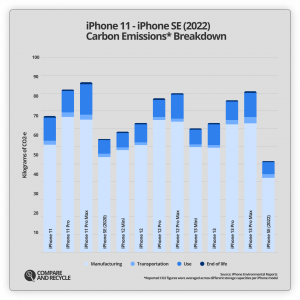For this project, my group members and I were studying ways in which iPhones may not be exactly the most environmentally friendly option when it comes to technology. In fact, according to Apple itself about 79% of the carbon emissions from the iPhone are emitted during the production phase, which should not come to a surprise since the manufacturing of products in factories is already polluting the air whether or not its Apple. Now a days, apple tries very often to persuade consumers to buy new phones, even when their current one is completely usable, refusing basic repair documentation for users. 45% of iPhone users have claimed that they would rather buy a new iPhone instead of fixing their current one, so the fact that over half of the consumers want to fix their current iPhones and are frequently denied the opportunity says a lot about the company prioritizing the environment.  The recycling industry has even mentioned on numerous occasions the amount of times perfectly reusable phones have been recycled. The graph above shows the amount of carbon emission is released when it comes to transportation, mining raw materials, as well other causes.
The recycling industry has even mentioned on numerous occasions the amount of times perfectly reusable phones have been recycled. The graph above shows the amount of carbon emission is released when it comes to transportation, mining raw materials, as well other causes.
Tag Archives: Recycling
Recycling and composting trends (1960-2018)

I complied a bar graph that showed the percentage increase in the number of different materials that was increased from 1960 on. This shows that through the years the amount of things recycled has increased along with having more things being able to be recycled. This could be caused by the increase in education and the advancements in technology.
| 1960 | 1970 | 1980 | 1990 | 2000 | 2005 | 2010 | 2015 | 2017 | 2018 | |
|---|---|---|---|---|---|---|---|---|---|---|
| Paper and Paperboard | 17% | 15% | 21% | 28% | 43% | 50% | 63% | 67% | 66% | 68% |
| Glass | 2% | 1% | 5% | 20% | 23% | 21% | 27% | 28% | 25% | 25% |
| Plastics | Neg. | Neg. | <1% | 2% | 6% | 6% | 8% | 9% | 9% | 9% |
| Yard Trimmings | Neg. | Neg. | Neg. | 12% | 52% | 62% | 58% | 61% | 69% | 63% |
| Lead-acid Batteries | Neg. | 76% | 70% | 97% | 93% | 96% | 99% | 99% | 99% | 99% |
Data from the United States Environmental Protection Agency. National Overview: Facts and Figures on Materials, Wastes, and Recycling.
(sorry if the image is blurry- my laptop was being difficult)
How to know what to recycle
A part of sustainability that is known of universally is recycling. However, understanding what can be recycled as opposed to what cannot is crucial in living a sustainable life. 19.91% of plastic waste has not been recycled and by 2050 the ocean will have a higher percentage of plastic waste than fish. Something interesting I came across was the amount of waste coming from Mardi Gras beads. Most college students probably own plastic bead necklaces for various parties or events. The question then becomes what to do with these beads when the event is over. Usually these beads are lost or forgotten about which makes them even more wasteful. Additionally, these beads are oftentimes made from a plastic that cannot be recycled in the same way as other plastic can be and it does not decompose in a proper way. Examples of non recyclable plastic is plastic coated wrapping paper, bioplastics, and polycarbonate. It is estimated that 25 million pounds of beads are thrown off of Mardi Gras floats each year creating pollution and waste. However, to combat this, in Mardi Gras parades usually beads are collected by a following float that will clean and reuse the beads for the year later. This is a very good way to reuse and reduce waste. The Greater Arc of New Orleans set up containers across the parade route to collect beads. These efforts are very commendable, but do raise concern of where these beads go when not used at a large, somewhat regulated event like a Mardi Gras parade. Additionally, it brings up the important issue of knowing how to dispose of things properly and what is recyclable as opposed to what is not.
Works Cited:
https://www.yummymath.com/wp-content/uploads/2022/02/MardiGras2022.pdf
https://comfyliving.net/recycling-statistics/#united-states-recycling-statistics
https://www.slrecyclingltd.co.uk/what-plastics-can-and-cannot-be-recycled/

